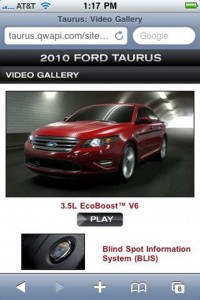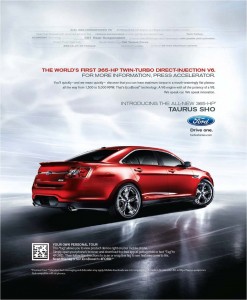
Take a pic of a Microsoft Tag on a Ford Taurus print ad with your smartphone and you've suddenly opened up a multimedia display explaining some of the new technology on the 2010 Taurus sedan.
The all-new 2010 Ford Taurus is loaded with an array of advanced technological features that the automaker hopes will win consumers over to the reborn nameplate.
But one of the newest features has been saved for Ford’s advertising campaign for the Taurus sedan, and helps transform the traditional, 2-dimensional brochure or magazine ad into a slick, multimedia display. The trick is a small, squiggly square printed in the corner of an ad, and known as a Microsoft Tag.
“The question was how do we bring the new technology on Taurus to life in an interesting and demonstrable way for potential buyers who want that information on their own terms?” says David Sanabria, communications manager at Ford.
The tags, developed by the Seattle-based software giant, are an updated version of the ubiquitous barcode system used in retailing and other applications. The box – which can be printed in black-and-white or color – contains a baker’s dozen bits of code that can contain a shortened Internet URL, or website address.
The real trick is to make it possible for a consumer to use that data to access that website. That simply requires a smartphone in which a so-called “app” has been installed. With the Apple iPhone, for example, that can be downloaded for free from the App Store. Once installed, a user simply aims the phone’s camera at one of the Microsoft Tags, snaps a pic and the software automatically goes to the appropriate website.
With the ads for Taurus, for example, that might land a potential customer on a web page containing a video that shows the car’s new Cross Traffic Alert system in use. The technology is designed to watch out for approaching cars when, say, the Taurus is backing out of a parking spot at a shopping mall.
“You don’t need an expert pic,” notes Sanabria, demonstrating that the software is smart enough to make sense of any a blurry shot of a tag. And for those who don’t have smartphones, ads can be embedded with a simple URL that a consumer can enter on a computer’s web browser.
Microsoft hopes to see the new tagging technology used by advertisers to transform traditionally stilted print advertising into multimedia campaigns that can be accessed on the consumer’s terms. Ford is one of the higher-profile users experimenting with the technology, and according to Sanabria, is confident enough to try tagging with another new model, the luxurious Lincoln MKS sedan.
If the system delivers, it could eventually be used in print campaigns for all of Ford products, the communications manager suggests.
One of the advantages is that a user of the Microsoft technology can track the results of its advertising in ways never possible before. To test that out, Ford has done about 800,000 direct mailings of “tagged” print advertising for Taurus.

The key to Tagging is a small variation of the classic barcode that contains 13 bytes of data that can be used to access a special website, simply by capturing it with a smartphone.
“We wouldn’t be surprised if (the number of people who use those ads to tag more information) were in the half-million range,” Sanabria estimates. “This customer is tech savvy.”
Once a user watches one of the video ads, they can be directed to additional information. In fact, Ford eventually hopes to use tagging to engage a potential Taurus customer in a sort of two-way dialogue.
The advertising “is not totally two-way yet. That’s the next step,” Sanabria hints. Not only might a consumer be able to request additional information, but possibly provide feedback or interact with a customer specialist.
“It’s the right technology,” he concludes. “But we need to put it out there and learn” what else is possible.

